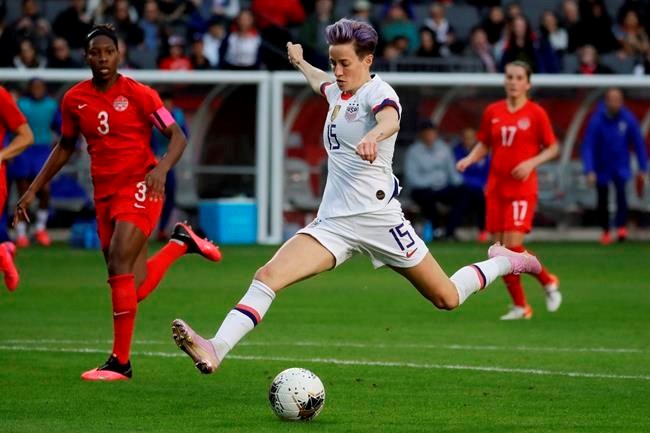Players on the U.S. women's national team are seeking more than $66 million in damages as part their gender discrimination suit against the U.S. Soccer Federation, part of a slew of court papers filed Thursday night ahead of a scheduled May trial.
Among the dozens of documents entered into the case record in U.S. District Court in Los Angeles were the separate collective bargaining agreements of the U.S. men's and women's teams. They showed a disparity in bonuses but also highlighted the different structures of the deals, including guaranteed salaries for the women and benefits the men do not receive from the federation.
The estimate of damages, including interest, was provided by Finnie Bevin Cook, an economist from Deiter Consulting Group, which was retained by the suing players.
As part of the preparation for a May 5 trial in the class-action suit, both sides revealed parts of pre-trial depositions.
U.S. women's star Megan Rapinoe, the reigning FIFA Player of the Year, said during a Jan. 16 deposition that Russell Sawyer, an outside lawyer for the USSF, stated during a bargaining session in June 2016 that “market realities are such that the women do not deserve to be paid equally to the men.”
USSF President Carlos Cordeiro was asked during a Jan. 29 deposition about a statement he made when campaigning that "our female players have not been treated equally."
"I felt then and I still feel to a degree, that the lack of opportunity for our female players was really what was at the root of some of their issues," Cordeiro said. "The fact that the Women's World Cup generates a fraction of revenue and a fraction of what the men get paid is a reflection, frankly, of lack of opportunity. ... Women's soccer outside of the United States doesn't have the same degree of respect."
Former USSF President Sunil Gulati, speaking during a Dec. 17 deposition, was questioned about the different competition the women and men face.
“One of which is the level of the opponent; two is where is the game played; three is how many of those opponents you have to play against to get to a certain level; four, which is really a combination of two of those, is how many other teams in the world are playing at any level that could give you a competitive match,” Gulati said.
"LeBron James doesn't get a bonus for getting 15 points and for the Lakers finishing out the playoffs," he added. "The expectations for him are different based on who they're playing against, what — who he is, what the level is."
Gulati said he read depositions in that case that discussed the distinctions between men's and women's soccer.
“There is an absolute difference, which not everyone seemed to agree to, but do I think that it's less attractive or less entertaining? I'm not saying that. Or relative quality, I'm not saying that,” he said. “But I'm also not saying, in terms of absolute level of -- whether it's speed or strength, they're the same. I think most people would accept that, too.”
A U.S. man who was on the roster for all 16 qualifiers during the failed effort to reach the 2018 World Cup earned $179,375 in payments from the U.S. Soccer Federation.
An American woman received $52,500 for being on the roster for the five World Cup qualifiers last year plus $147,500 for her time at the World Cup, including a $37,500 roster bonus and $110,000 for winning the title in France.
The USSF keeps 16-21 women's players under contract in each year of the current
Women receive 75% of salary on maternity leave for up to one year, and a player has the longer of three months or two training camps to return to full fitness. A player can receive 75% of salary for up to three months when adopting a child and a $50 daily stipend for child care during training and play. The USSF also pays for health, dental and vision insurance for the women.
When the men last qualified for the World Cup in 2014, their player pool got a $2 million payment, and each player earned $55,000 for making the roster and $5,500 per match. The player pool earned $175,000 per point for the group phase, a total of $700,000, plus $3.6 million for reaching the round of 16.
The USSF in its filing pointed out it received $9 million from FIFA for the men reaching the second round of the 2014 World Cup, but $2 million for the women winning in 2015 and $4 million for their victory in 2019.
There is parity is per diems: the women get $62.50 daily while in the U.S. and $75 internationally, the same as the men received under terms of their expired deal that covered 2015-18. And men and women both receive $1.50 per paid attendance for home matches controlled by the USSF.
___
More AP soccer: https://apnews.com/Soccer and https://twitter.com/AP_Sports
Ronald Blum, The Associated Press


